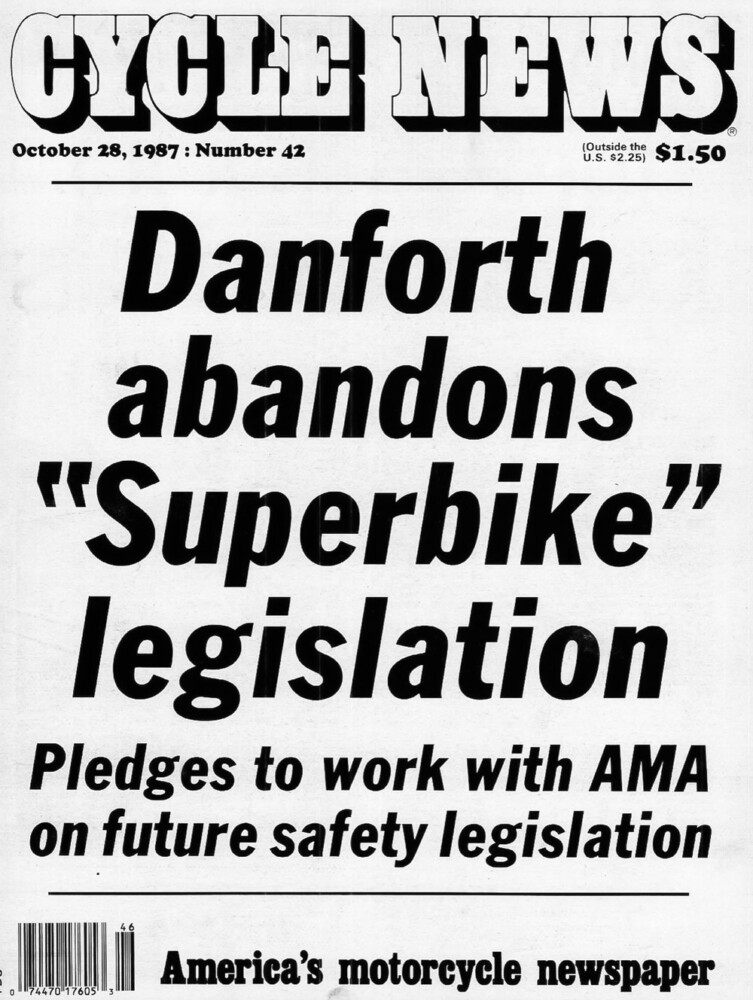Cycle News Archives
COLUMN
Motorcyclists fought and won the battle to kill the Motorcycle Safety Act of 1987
By Kent Taylor
Motorcyclists around the country fought and won the battle to kill the Motorcycle Safety Act of 1987, which would’ve taken sportbikes off the roads in the USA.

It is something of a paradox, but it could be argued that motorcyclists make up the world’s largest group of loners. We may ride in groups, belong to clubs, or sit on the same starting line with our fellow racers, but beneath all of the Kevlar, leather and plastic layers, there is a solo soul who wants only to be in a place called “away from everything.”
In the late 1980s, these free-spirited cyclists encountered a very real and formidable opponent, one that had the power to change the way they rode. It was the U.S. Government versus the motorcyclists and had not this collection of individualists gathered together to become one giant two-wheeled lobbyist, we would be living in a very different world of motorcycling today.
The man in the government suit was a United States senator from Missouri by the name of John Claggett Danforth. Along with being an heir to the Ralston Purina pet food company, Danforth was an attorney and an ordained Episcopal priest. He served a long and distinguished career in the Senate and even made George W. Bush’s short list of running mates in 2000. In 1987, Danforth became motorcycling’s public enemy number one when he introduced federal legislation that would’ve banned nearly all sportbikes.
It was called the “Motorcycle Safety Act of 1987,” and it might as well have been called the Motorcycle Safety Axe because it was designed to chop off the head of the sportbike industry. Danforth was a lawmaker with a passion for making safe the way for all motorized travel and he pushed for drunk driving legislation, high-mounted brake lights on vehicles, mandatory drug tests for truckers, etc. The Missouri senator wanted all to be well on the roads and when he was handed a video by the Insurance Institute for Highway Safety (IIHS), he was shocked to see young riders on powerful sportbikes, street racing in the canyons of SoCal, their dare-devilish deeds often ending in serious injury or death. The Motorcycle Safety Act was born, and had it become law, it was likely going to take these bikes off of American roads.
The IIHS is a non-profit organization, and according to their website, they cannot, by law, lobby politicians. It was funded by the insurance companies, which is an industry that has never met a profit it didn’t like, and it is safe to say that the video provided to Danforth probably didn’t leave the viewer with a warm, On Any Sunday kind of vibe.
Indeed, the IIHS video led Danforth to believe that these sporting motorcycles, especially the 900cc and higher models, were unsafe in the hands of the young and reckless. In an interview with American Motorcyclist magazine (December 1987), Danforth said, “What happened is that I looked at the film, [and] the suggestion was: Look, here is a product that is specifically targeted for kids, it goes from zero to 60 in two-point-something seconds and it is inherently dangerous. Let’s introduce a bill that instructs the Department of Transportation to conduct a rulemaking on the product itself. I think what’s clear is that there is a problem.”
There were many problems, indeed. Most of them started with the study itself, which appeared to have been an oversimplification of a complex issue. The IIHS folks built their case mostly on police reports of crashes. Left out were important questions. Why did the rider crash? Had this victim ever attended a rider education class of any sort? Road type? Important information, known as exposure data, was missing from the report.
For their part, the IIHS spokesperson, Brian O’Neill, defended their study or, rather, defended the study method used. “It’s the standard used for studies of this kind involving passenger vehicles and trucks,” he said. “If you let the exposure data hang you up, you never do the study.”
There are many more juicy details behind the story of the Motorcycle Safety Act. Conspiracy theorists will polish up their tinfoil hats when they learn that at the same time the IIHS was providing videos to Senator Danforth, the CBS television network was airing a “West 57th Street” episode, all about (cue the theremin) dangerous sportbikes! It seemed as if the study had been made available to the network, which then produced an exposé on the very topic that Senator Danforth was addressing in Washington, D.C. According to the American Motorcyclist, CBS even used footage that was provided by the IIHS.

A dubious media attack, an agency that appeared to be doing the bidding of the powerful insurance industry, and a well-respected U.S. Senator wanting to save American youth from a too-fast ride on the highway to hell. The wheels were in motion, upshifting and gaining momentum. It was going to take a unified effort to save sportbike riding.
Which is exactly what happened. A powerful coalition of riders burned up the phone lines, flooded their senators’ mailboxes, and made a noise louder than anything Pops Yoshimura ever imagined. Senator Danforth conceded, saying, “I’m totally overwhelmed. When I conduct, say, a town meeting, either in person or over the telephone…it’s almost certain that I’ll get at least one call, maybe two, about the motorcycling bill.” He went on to credit motorcyclists for creating a “buzz saw” with their voices. Danforth called the bill “a dead-end street” and that “it’s got about as much life to it as last year’s snow.
“I didn’t know there was such a thing as the American Motorcyclist Association,” Danforth said. “I should’ve talked to you people.”
Danforth was a respected U.S. Senator who listened to the cry of the people and even acknowledged his own mistakes. Today, nearly everyone would agree that 2025’s sportbikes are safer than anything made in 1987. The pursuit of happiness continues, made possible by a unified pack of loners. CN
Click here to read the Archives Column in the Cycle News Digital Edition Magazine.
Subscribe to six decades of Cycle News Archive issues
